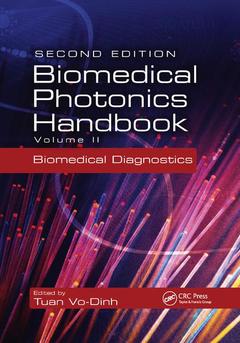Biomedical Photonics Handbook (2nd Ed.) Biomedical Diagnostics
Coordonnateur : Vo-Dinh Tuan

Shaped by Quantum Theory, Technology, and the Genomics Revolution
The integration of photonics, electronics, biomaterials, and nanotechnology holds great promise for the future of medicine. This topic has recently experienced an explosive growth due to the noninvasive or minimally invasive nature and the cost-effectiveness of photonic modalities in medical diagnostics and therapy. The second edition of the Biomedical Photonics Handbook presents fundamental developments as well as important applications of biomedical photonics of interest to scientists, engineers, manufacturers, teachers, students, and clinical providers. The second volume, Biomedical Diagnostics, focuses on biomedical diagnostic technologies and their applications from the bench to the bedside.
Represents the Collective Work of over 150 Scientists, Engineers, and Clinicians
Designed to display the most recent advances in instrumentation and methods, as well as clinical applications in important areas of biomedical photonics to a broad audience, this three-volume handbook provides an inclusive forum that serves as an authoritative reference source for a broad audience involved in the research, teaching, learning, and practice of medical technologies.
What?s New in This Edition:
A wide variety of photonic biochemical sensing technologies have already been developed for clinical monitoring of physiological parameters, such as blood pressure, blood chemistry, pH, temperature, and the presence of pathological organisms or biochemical species of clinical importance. Advanced photonic detection technologies integrating the latest knowledge of genomics, proteomics and metabolomics allow sensing of early disease state biomarkers, thus revolutionizing the medicine of the future. Nanobiotechnology has opened new possibilities for detection of biomarkers of disease, imaging single molecules and in situ diagnostics at the single cell level. In addition to these state-of-the art advancements, the second edition contains new topics and chapters including:
? Fiber Optic Probe Design
? Laser and Optical Radiation Safety
? Photothermal Detection
? Multidimensional Fluorescence Imaging
? Surface Plasmon Resonance Imaging
? Molecular Contrast Optical Coherence Tomography
? Multiscale Photoacoustics
? Polarized Light for Medical Diagnostics
? Quantitative Diffuse Reflectance Imaging
? Interferometric Light Scattering
? Nonlinear Interferometric Vibrational Imaging
? Multimodality Theranostics Nanoplatforms
? Nanoscintillator-Based Therapy
? SERS Molecular Sentinel Nanoprobes
? Plasmonic Coupling Interference Nanoprobes
Comprised of three books: Volume I: Fundamentals, Devices, and Techniques; Volume II: Biomedical Diagnostics; and Volume III: Therapeutics and Advanced Biophotonics, this second edition contains eight sections, and provides introductory material in each chapter. It also includes an overview of the topic, an extensive collection of spectroscopic data, and lists of references for further reading.
Biomedical Analysis, Sensing and Imaging. Biosensors for Medical Applications. Glucose Monitoring. Biochips and MicroArrays: Tools for the New Medicine. Atomic Spectroscopy for Biological and Clinical Analysis. Flow Cytometry. Capillary Electrophoresis Techniques in Biomedical Analysis. Surface Plasmon Resonance Imaging: Principle, Development, and Biomedical Applications. Surface-Enhanced Raman Scattering (SERS) for Biomedical Diagnostics. Functional Imaging with Diffusing Light. Molecular Contrast Optical Coherence Tomography. Multiscale Photoacoustic Microscopy and Macroscopy. Polarized light for Medical Diagnostics. Optical Pumping and MRI of Hyperpolarized Spins. Biomedical Diagnostics and Optical Biopsy. Fluorescence Spectroscopy for Biomedical Diagnostics. Elastic-Scattering Spectroscopy and Diffuse Reflectance. Quantitative Diffuse Reflectance Imaging of Tumor Margins. Near Infrared Fluorescence Imaging and Spectroscopy in Random Media and Tissues. Interferometric light scattering techniques for measuring nuclear morphology and detecting dysplasia. Ultrasonically Modulated Optical Imaging. Optoacoustic Tomography. Raman Spectroscopy: From Benchtop to Bedside. Fourier Transform Infrared (FTIR) Microspectroscopic Methods for Biomedical Analyses: From Single Point Detection to Two-Dimensional Imaging. Photon Migration Spectroscopy Frequency-Domain Techniques.
Tuan Vo-Dinh is the R. Eugene and Susie E. Goodson Distinguished Professor of biomedical engineering, professor of chemistry, and director of the Fitzpatrick Institute for Photonics at Duke University. He received a B.S. in physics in 1970 from EPFL (Ecole Polytechnique Federal de Lausanne) in Lausanne and a Ph.D. in physical chemistry in 1975 from ETH (Swiss Federal Institute of Technology) in Zurich, Switzerland. Dr. Vo-Dinh has authored over 350 publications in peer-reviewed scientific journals. He is the author of a textbook on spectroscopy and editor of 6 books. He has received numerous awards and holds over 37 U.S. and international patents.
Date de parution : 10-2019
17.8x25.4 cm
Date de parution : 06-2014
Ouvrage de 889 p.
17.8x25.4 cm
Thèmes de Biomedical Photonics Handbook :
Mots-clés :
Source Detector Separation; OCT Image; Diuse Reectance; Raman Spectroscopy; Magnetic Eld; DNA Probe; Oat; SERS Substrate; Detector Bers; Local Oscillations; Absorption Coecient; FTIR Imaging; Vis Absorbance; SERS Spectrum; Photoacoustic Microscopy; Stokes Vector; Ip Angle; SERS Probe; D1 Line; SERS Detection; Raman Spectra; SPR Biosensor; Scattering Coecient; Mueller Matrix; Ow Cytometers



